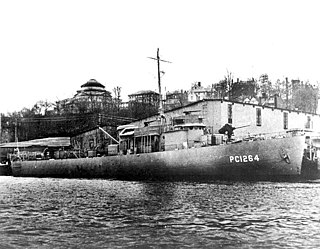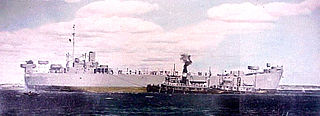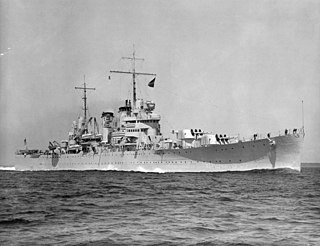
USS PC-815 was a PC-461-class submarine chaser built for the United States Navy during World War II. Its first commander, for about eighty days in 1943, was L. Ron Hubbard, who later became the founder of Scientology. After Hubbard was removed from command for conducting unauthorized gunnery practice in Mexican territorial waters, the PC-815 served as a shore patrol vessel off San Diego, California.

USS PC-1264 was a PC-461-class submarine chaser built for the United States Navy during World War II. She was one of only two U.S. Navy ships to have a predominantly African-American enlisted complement during the war, the other being the Evarts-class destroyer escortUSS Mason.

USS Impetuous (PYc-46) was private yacht that served as a patrol boat of the United States Navy in both World War I and World War II under different names.

This is the complete order of battle of Allied and Japanese forces during the Borneo campaign of 1945. As the campaign was fought in three geographically separate areas and the same air and naval units supported more than one of these battles the order of battle is split into the three areas.

USS Marion County (LST-975) was an LST-542-class tank landing ship built for the United States Navy during World War II. Like many of her class, she was not named and is properly referred to by her hull designation. She was later named after counties in seventeen U. states, she was the only US Naval vessel to bear the name.

USS Krishna (ARL-38) was one of 39 Achelous-class landing craft repair ships built for the United States Navy during World War II. Named for Krishna, she was the only U.S. Naval vessel to bear the name, and only one of three ships to be named after a Hindu deity.

Operation Game Warden was a joint operation conducted by the United States Navy and South Vietnamese Navy in order to deny Viet Cong access to resources in the Mekong Delta. Game Warden and its counterpart Operation Market Time are considered to be two of the most successful U.S. Naval actions during the Vietnam War.
USS LST-900 was an LST-542-class tank landing ship in the United States Navy during World War II. Late in her career, she was renamed Linn County (LST-900)—after counties in Iowa, Kansas, Missouri, and Oregon—but saw no active service under that name.

USS LST-821, renamed USS Harnett County (LST-821/AGP-281), was an LST-542-class tank landing ship built for the United States Navy during World War II. She was named for Harnett County, North Carolina and was the only U.S. Naval vessel to bear the name. She served the United States Navy in World War II and the Vietnam War. She was transferred to South Vietnam's Republic of Vietnam Navy, which named her RVNS My Tho (HQ-800).

USS Marinette County (LST-953) was an LST-542-class tank landing ship built for the United States Navy during World War II. Like many of her class, she was not named and is properly referred to by her hull designation. She was later named after Marinette County, Wisconsin, she was the only US Naval vessel to bear the name.

USS Sturdy (PC-460/PYc-50) was a yacht converted to a patrol boat acquired by the U.S. Navy for the task of patrolling the coastal waters of the U.S. East Coast during World War II. Her primary task was to guard the coastal area against German submarines.

An armed yacht was a yacht that was armed with weapons and was typically in the service of a navy. The word "yacht" was originally applied to small, fast and agile naval vessels suited to piracy and to employment by navies and coast guards against smugglers and pirates. Vessels of this type were adapted to racing by wealthy owners. The origin of civilian yachts as naval vessels, with their speed and maneuverability, made them useful for adaptation to their original function as patrol vessels. In the United States Navy armed yachts were typically private yachts expropriated for government use in times of war. Armed yachts served as patrol vessels during the Spanish–American War and the World Wars. In the latter conflicts, armed yachts were used as patrol vessels, convoy escorts, and in anti-submarine duties. In the United States, yachts were purchased from their owners with the owners given an option to repurchase their yacht at the close of hostilities.

The PC-461-class submarine chasers were a class of 343 submarine chasers constructed mainly for the US Navy and built from 1941–1944. The PC-461s were based primarily on two experimental submarine chasers, PC-451 and PC-452. While PC-461 began the series, the first of the class to enter service was PC-471. As part of the Lend-Lease program, 46 ships of this class were transferred to allies of the United States. Fifty-nine PC-461s were converted to other types of patrol vessels. Eight vessels of this class were lost, and one vessel was lost after conversion to a PGM-9-class motor gunboat. Only one of the class, USS PC-566 commanded by Lieutenant Commander Herbert G. Claudius, actually sank a submarine, U-166, during World War II; however, the website 'Patrol Craft Sailors Association' cites PC-461-class ships sinking or assisting sinking up to 6 German and Japanese subs.
USS LST-766 was an LST-542-class Landing Ship, Tank in the United States Navy during World War II that took part in the amphibious landings during the war in the Far East.

The Action of 24 July 1945 was one of the final naval battles during the Pacific Theater of World War II. In an attempt to destroy as many allied ships as possible, the Imperial Japanese Navy began arming their submarine fleet with manned torpedoes called kaitens. The Action of 24 July 1945 concerns the battle between a convoy of U.S. Navy warships off Luzon and the Japanese submarine I-53 and her kaitens.

The amphibious Battle of Gela was the opening engagement of the American portion of the Allied Invasion of Sicily during World War II. United States Navy ships landed United States Army troops along the eastern end of the south coast of Sicily; and withstood attacks by Luftwaffe and Regia Aeronautica aircraft while defending the beachhead against German tanks and Italian tanks of the Livorno Division until the Army captured the Ponte Olivo Airfield for use by United States Army Air Forces planes. The battle convinced United States Army officers of the value of naval artillery support, and revealed problems coordinating air support from autonomous air forces during amphibious operations.

USS LST-471 was a United States Navy LST-1-class tank landing ship used in the Asiatic-Pacific Theater during World War II. As with many of her class, the ship was never named. Instead, she was referred to by her hull designation.

USS PC-598 was a 173' metal hulled PC-461-class submarine chaser that saw duty in the United States Navy in the Pacific Theater during World War II. It was converted to an amphibious landing control vessel during the war and reclassified a Patrol Craft – Control or PCC. It participated in six amphibious invasions as a control vessel.

USS LST-487 was an LST-1-class tank landing ship built for the United States Navy during World War II.
USS LST-921 was an LST-542-class tank landing ship in the United States Navy. Like many of her class, she was not named and is properly referred to by her hull designation.